Sempervivum
Sempervivum (Brit. /sɛmpəˈvaɪvəm/,[1] U.S. [̩sɛ̃mpeɹ'vivũm]) is a genus of about 40 species of flowering plants in the family Crassulaceae, commonly known as houseleeks. Other common names include liveforever (the source of the taxonomical designation Sempervivum, literally "always/forever alive") and hen and chicks, a name shared with plants of other genera as well. They are succulent perennials forming mats composed of tufted leaves in rosettes. In favourable conditions they spread rapidly via offsets, and several species are valued in cultivation as groundcover for dry, sunny locations.[2]
| Sempervivum | |
|---|---|
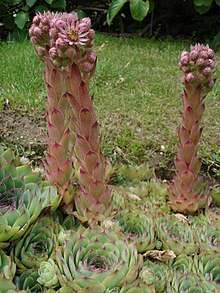 | |
| Flowering Sempervivum tectorum | |
| Scientific classification | |
| Kingdom: | Plantae |
| Clade: | Tracheophytes |
| Clade: | Angiosperms |
| Clade: | Eudicots |
| Order: | Saxifragales |
| Family: | Crassulaceae |
| Subfamily: | Sempervivoideae |
| Tribe: | Semperviveae |
| Genus: | Sempervivum L. |
| Species | |
|
List
| |
Habitat
Houseleeks exist from Morocco to Iran, through the mountains of Iberia, the Alps, Carpathians, Balkan mountains, Turkey, the Armenian mountains, in the northeastern part of the Sahara Desert, and the Caucasus. Their ability to store water in their thick leaves allows them to live on sunny rocks and stony places in the mountain, subalpine and alpine belts. Most are hardy to US zone 4, and will handle warm climates to about zone 8.
Subtropical origin
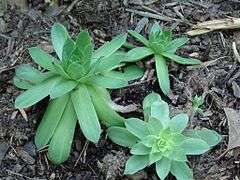
Morphologically, they are similar to the genera Jovibarba, Aeonium, Greenovia, Aichryson, and Monanthes, occurring mainly in Macaronesia (Azores, Canary Islands, Cape Verde, Madeira). Some botanists include some or all of these genera within a wider interpretation of Sempervivum, particularly Jovibarba.
Origin of name
The name Sempervivum has its origin in the Latin semper ("always") and vivus ("living"), because this perennial plant keeps its leaves in winter and is very resistant to difficult conditions of growth.[3] The common name "houseleek" is believed to stem from the traditional practice of growing plants on the roofs of houses to ward off fire and lightning strikes. Some Welsh people still hold the old folk belief that having it grow on the roof of the house ensures the health and prosperity of those who live there.[4][5] The plant is not closely related to the true leek, which belongs to the onion family.
Other common names reflect the plant's ancient association with Thor, the Norse god of thunder, and the Roman Jupiter. Hence names such as "Jupiter's beard" and the German Donnerbart ("thunder beard").[3]
Growth and reproduction
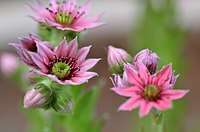
Houseleeks grow as tufts of perennial but monocarpic rosettes. Each rosette propagates asexually by lateral rosettes (offsets, "hen and chicks"), by splitting of the rosette (only Jovibarba heuffelii) or sexually by tiny seeds.
Typically, each plant grows for several years before flowering. Their hermaphrodite flowers have first a male stage. Then the stamens curve themselves and spread away from the carpels at the center of the flower, so self-pollination is rather difficult. The colour of the flowers is reddish, yellowish, pinkish, or—seldom—whitish. In Sempervivum, the flowers are actinomorphic (like a star) and have more than six petals, while in Jovibarba, the flowers are campanulate (bell-shaped) and are pale green-yellow with six petals. After flowering, the plant dies, usually leaving many offsets it has produced during its life.
Identification
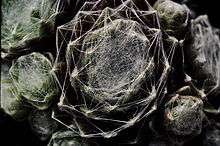
The genus Sempervivum is usually easy to recognize, although it may sometimes be confused with the genus Echeveria. However, its species are often not easy to identify. Even one single clone can look very different under various growth conditions (modifications) or different times of the year. The members of this genus are very similar and closely linked to each other. As a consequence, many subspecies, varieties, and forms were described, without well-defined limits between them. As a second consequence, there is a high frequency of natural hybrids in this genus and the possibility of back-crossings of these. However, more or less 40 species can be individualized in the whole area of the genus, but there are many more local populations, without nomenclatural valour but sometimes with their own characters.
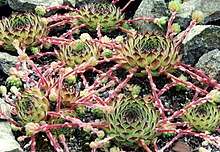
In the Alps, for example, the most distributed species are S. tectorum (common houseleek, sometimes called S. alpinum), S. montanum (mountain houseleek) and S. arachnoideum (cobwebbed houseleek), each one with several subspecies. More local are the yellow-flowered S. wulfenii and S. grandiflorum, and the beautiful limestone houseleek (S. calcareum). More rare are S. dolomiticum and mainly S. pittonii. S. pittonii is a small yellow-flowered jewel growing only on two mountains slopes near Kraubath in the Mur valley in Austria and is very threatened.
On roofs or old walls S. tectorum can be found, more or less wild, very far out of its natural area. It is a very old medicinal and witch-plant. Some superstitious people believe this plant is able to protect a house from lightning.[6]
Herbalism
It has been used historically and is used presently for purported health benefits. It has no known side effects (aside from being an emetic in large doses) or drug interactions. Common herbal uses are stopping bad cases of diarrhea by drinking the juice of the leaf or eating the leaves directly, and the juice is commonly applied directly to the skin for many of the same uses as aloe vera such as burns, warts and insect bites.[5][7] It is furthermore said to bring relief in cases of swellings and water retention.[8]
The famous English herbalist Culpepper says 'Our ordinary Houseleek is good for all inward heats, as well as outward, and in the eyes or other parts of the body: a posset made of the juice is singularly good in all hot agues, for it cooleth and tempereth the blood and spirits and quencheth the thirst; and is also good to stay all deflection or sharp and salt rheums in the eyes, the juice being dropped into them. If the juice be dropped into the ears, it easeth pain.... It cooleth and restraineth all hot inflammations St. Anthony's fire (Erysipelas), scaldings and burnings, the shingles, fretting ulcers, ringworms and the like; and much easeth the pain and the gout.'[4]
Garden and container plants
.jpg)
Although their subtropical cousins are very frost-sensitive, sempervivums are among the most frost-resistant succulents, making them popular garden plants. They tend to grow best in dry conditions with well-draining, sandy soil to prevent soggy roots. They require only moderate watering, especially during warmer months, with occasional protection from extreme sun exposure.
Sempervivums also make suitable plants for containers, and do well in breathable terracotta, concrete, and cement pots. They have also been known to grow in rock crevices, metal containers, succulent wreaths, roof shingles, and anywhere else that allows adequate root drainage.
Cultivars
Collectors are numerous and often have many different cultivars in their collections. Sempervivums are very variable plants and hence hundreds, maybe thousands of cultivars have been created, but a lot of them are not much different from each other. The main interest of these cultivars is not their flowers, but form and color of the rosette-leaves.
The following species and cultivars - some of mixed or uncertain parentage - have gained the Royal Horticultural Society’s Award of Garden Merit:-[9]
Gallery
- A selection of Sempervivum cultivars, for sale at Gardeners' World Live 2012
.jpg) A personal collection of potted sempervivums
A personal collection of potted sempervivums.jpg) Sempervivum pittoni
Sempervivum pittoni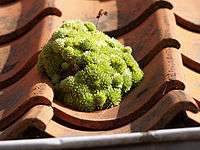 Sempervivum tectorum on a roof
Sempervivum tectorum on a roof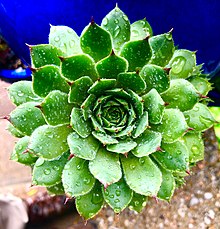 Close up of large sempervivum
Close up of large sempervivum
References
- Oxford English Dictionary, 2nd Edition 1989
- RHS A-Z encyclopedia of garden plants. United Kingdom: Dorling Kindersley. 2008. p. 1136. ISBN 978-1405332965.
- Harrison, Lorraine (2012). RHS Latin for gardeners. United Kingdom: Mitchell Beazley. p. 224. ISBN 9781845337315.
- "Houseleek". Botanical.com.
- "House Leek". Garden Herbs.
- Mrs M Grieve (1994). Mrs C F Leyel (ed.). A Modern Herbal. London, United Kingdom: Tiger Books International. p. 422. ISBN 1855012499.
- "Find a Vitamin or Supplement: Houseleek". WebMD.
- 1929-, Duke, James A. (2002). Handbook of medicinal herbs. Duke, James A., 1929- (2nd ed.). Boca Raton, FL: CRC Press. ISBN 0849312841. OCLC 48876592.CS1 maint: numeric names: authors list (link)
- "AGM Plants - Ornamental" (PDF). Royal Horticultural Society. July 2017. p. 96. Retrieved 9 November 2018.
- "RHS Plantfinder - Sempervivum arachnoideum". Retrieved 9 November 2018.
- "RHS Plantfinder - Sempervivum arachnoideum subsp. tomentosum". Retrieved 9 November 2018.
- "RHS Plantfinder - Sempervivum 'Bronco'". Retrieved 9 November 2018.
- "RHS Plantfinder - Sempervivum calcareum 'Extra'". Retrieved 9 November 2018.
- "RHS Plantfinder - Sempervivum calcareum 'Guillaume'". Retrieved 9 November 2018.
- "RHS Plantfinder - Sempervivum ciliosum". Retrieved 9 November 2018.
- "RHS Plantfinder - Sempervivum 'Lilac Time'". Retrieved 9 November 2018.
- "RHS Plantfinder - Sempervivum 'Othello'". Retrieved 8 November 2018.
- "RHS Plantfinder - Sempervivum pittonii". Retrieved 9 November 2018.
- "RHS Plantfinder - Sempervivum 'Reinhard'". Retrieved 9 November 2018.
- "RHS Plantfinder - Sempervivum tectorum". Retrieved 9 November 2018.
- Praeger, Lloyd R. (1932). An Account of the Sempervivum Group. ISBN 978-3-443-50036-8.
External links
| Wikimedia Commons has media related to Sempervivum. |
| Wikispecies has information related to Sempervivum |